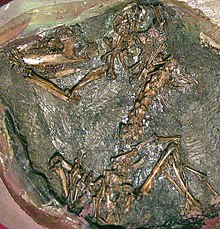| Dryolestida | |
|---|---|

| |
| Skeleton of Henkelotherium | |
| Scientific classification | |
| Domain: | Eukaryota |
| Kingdom: | Animalia |
| Phylum: | Chordata |
| Class: | Mammalia |
| Clade: | Cladotheria |
| Superorder: | †Dryolestoidea Butler, 1939 |
| Order: | †Dryolestida Prothero, 1981 |
| Families and genera | |
Dryolestida is an extinct order of mammals, known from the Jurassic and Cretaceous. They are considered basal members of the clade Cladotheria, close to the ancestry of therian mammals. It is also believed that they developed a fully mammalian jaw and also had the three middle ear bones. Most members of the group, as with most Mesozoic mammals, are only known from fragmentary tooth and jaw remains.
The group contains Dryolestidae and the possibly paraphyletic Paurodontidae, and some other unplaced genera, which were small insectivores, known from the Middle Jurassic to Early Cretaceous of Laurasia, primarily Europe and North America, with a single record from Asia. During the Late Jurassic in North America and from the Late Jurassic to Early Cretaceous in Europe, they were among the most diverse mammal groups.[1] They have sometimes been placed as part of a broader group, the "Dryolestoidea", which typically includes Dryolestida and Meridiolestida, a diverse group of mammals including both small insectivores and mid-large sized herbivores known from the Late Cretaceous to Miocene of South America and possibly Antarctica. However, in many phylogenetic analyses, Meridiolestida are recovered as an unrelated group of basal cladotherians, rendering "Dryolestoidea" paraphyletic.[2]
Dryolestids were formerly considered part of Pantotheria and/or Eupantotheria. The clade Quirogatheria, erected by José Bonaparte in 1992, is often used as a synonym for Dryolestida. Originally, Quirogatheria was meant to include Brandoniidae, but this family is now included with the dryolestids.
- ^ Martin, Thomas; Averianov, Alexander O.; Schultz, Julia A.; Schwermann, Achim H.; Wings, Oliver (2021-05-16). "A derived dryolestid mammal indicates possible insular endemism in the Late Jurassic of Germany". The Science of Nature. 108 (3): 23. Bibcode:2021SciNa.108...23M. doi:10.1007/s00114-021-01719-z. ISSN 0028-1042. PMC 8126546. PMID 33993371.
- ^ Lasseron, Maxime; Martin, Thomas; Allain, Ronan; Haddoumi, Hamid; Jalil, Nour-Eddine; Zouhri, Samir; Gheerbrant, Emmanuel (2022-06-02). "An African Radiation of 'Dryolestoidea' (Donodontidae, Cladotheria) and its Significance for Mammalian Evolution". Journal of Mammalian Evolution. 29 (4): 733–761. doi:10.1007/s10914-022-09613-9. ISSN 1064-7554. S2CID 249324444.